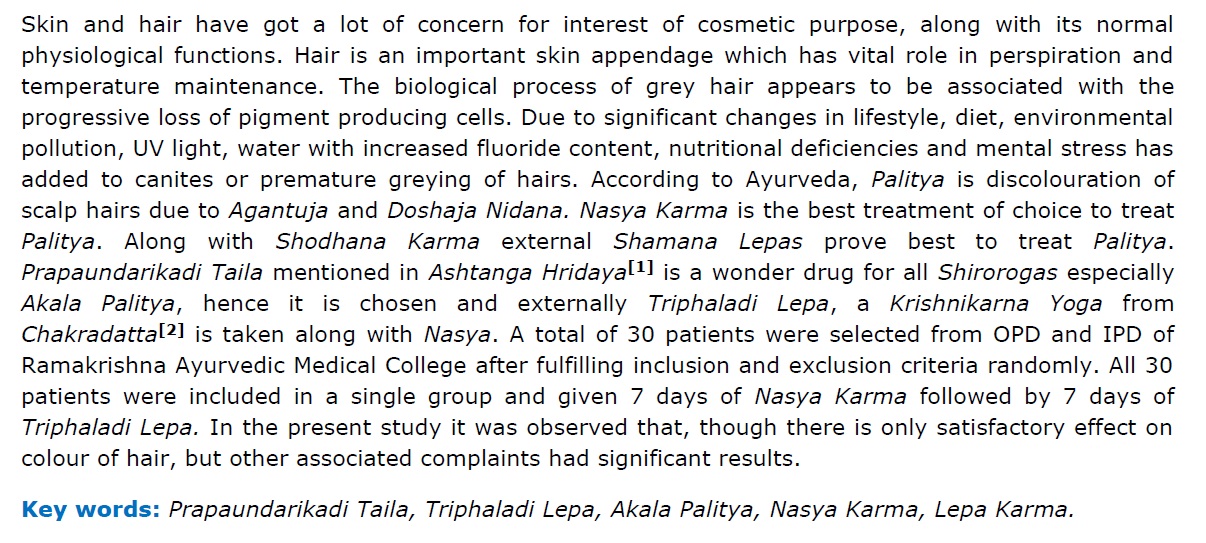The clinical effect of Prapaundarikadi Taila Nasya and Triphaladi Lepa in the management of Akala Palitya
DOI:
https://doi.org/10.21760/jaims.v6i5.1482Keywords:
Prapaundarikadi Taila, Triphaladi Lepa, Akala Palitya, Nasya Karma, Lepa Karma.Abstract
Skin and hair have got a lot of concern for interest of cosmetic purpose, along with its normal physiological functions. Hair is an important skin appendage which has vital role in perspiration and temperature maintenance. The biological process of grey hair appears to be associated with the progressive loss of pigment producing cells. Due to significant changes in lifestyle, diet, environmental pollution, UV light, water with increased fluoride content, nutritional deficiencies and mental stress has added to canites or premature greying of hairs. According to Ayurveda, Palitya is discolouration of scalp hairs due to Agantuja and Doshaja Nidana. Nasya Karma is the best treatment of choice to treat Palitya. Along with Shodhana Karma external Shamana Lepas prove best to treat Palitya. Prapaundarikadi Taila mentioned in Ashtanga Hridaya[1] is a wonder drug for all Shirorogas especially Akala Palitya, hence it is chosen and externally Triphaladi Lepa, a Krishnikarna Yoga from Chakradatta[2] is taken along with Nasya. A total of 30 patients were selected from OPD and IPD of Ramakrishna Ayurvedic Medical College after fulfilling inclusion and exclusion criteria randomly. All 30 patients were included in a single group and given 7 days of Nasya Karma followed by 7 days of Triphaladi Lepa. In the present study it was observed that, though there is only satisfactory effect on colour of hair, but other associated complaints had significant results.
Downloads
References
Prof. K R Srikanta murthy, translator, Vagbhata, Astanga hrudaya, krishnadas academy, Varanasi (vol 3), Uttarasthana, chapter 24/44-45,p232.
Indradeva Tripathi, Chakradatta of Chakrapanidatta with Vaidayaprabha hindi commentary, Chaukambha Sanskrit sansthan, Varanasi, chapter 55/112, p321.
Sagar Sharma, Review of premature graying of hair (Akala Palitya) and its treatment in ayurveda, Int J Ayu pharm chem vol.3 issue 1, 2015,p188.
Sagar Sharma, Review of premature graying of hair (Akala Palitya) and its treatment in ayurveda, Int J Ayu pharm chem vol.3 issue 1, 2015,p188.
Vaidya Yadavji Trikamji Acharya ed, Ayurveda deepika commentary of Chakrapanidatta, Charaka samhita chikitsa sthana 26/132, 5th edition 2001, Chaukambha Sanskrit Sansthan Varanasi, p606.
Vaidya Yadavji Trikamji acharya ed, Nibandha sangraha commentary of Dalhana and Nyayachandrika panjika commentary of Gayadas on Nidana sthana, Sushruta Samhita Nidana sthana 13/37, 7th edition 2002, Chaukambha Orientalia, Varanasi, pp332
Harisastri paradarakar ed, Sarvangasundara commentary of Arunadatta and Ayurveda Rasayana commentary of Hemadri, Astanga Hrudaya Uttaratantra 23/29,30 7th edition 1982, Chaukambha Orientalia Varanasi, p332.
Brahmanand Tripathi edited, Ashtanga hridaya Uttara sthana shiroroga vignjaniya adhyaya, chapter 23, sloka 29, chaukambha Sanskrit sansthan, delhi, reprinted 2003, p1054.
Shivaprasad Sharma edited, Astanga Sangraha, uttarastana, chapter 27, sloka 22, edition 2006. Choukhamba Sanskrit Series, Varanasi. p766.
Yadunandana Upadyaya ed. Madava Nidana, Uttarardha, chapter 55, sloka 32. 30th edition, 2001. Chaukhamba Sanskrit Sanstan, Varanasi. p205.
Vaidya Yadavji Trikamji Acharya ed. Susruta Samhita, Nidana Sthana, Chapter 13, Shloka 37. reprint 2008 Chaukhamba Surabarathi Prakashan, Varanasi. p322.
Sharma SP, Astanga Samgraha of Vrddha Vagbhata with Sasilekha commentary of Indu, Uttaratantra 27/31-33; Reprinted ed. Varanasi, Chaukambha Sanskrit Series Office; 2008; p242.
Brahmasankara Misra edited, Bhavaprakasha, Uttarardha, Chapter 61, sloka 1, 7th edition 1990, Choukhamba Sanskrit Sanstan, Varanasi. p584.
https://www.ncbi.nlm.nih.gov/pmc/articles/PMC4830165/
Shyam Babu Singh, Effect of Prapaundarikadi Taila on Palitya, A Pilot Study; Int J pharm chem. 2016, vol5, issue 2, p46.















